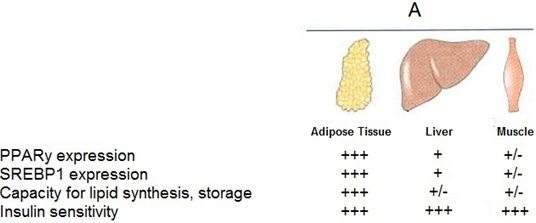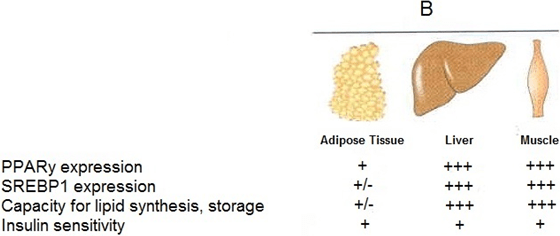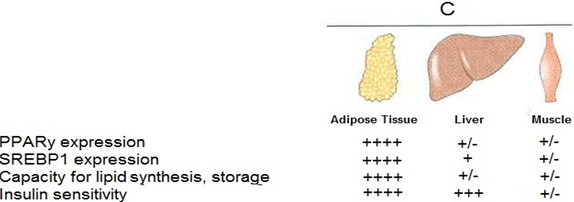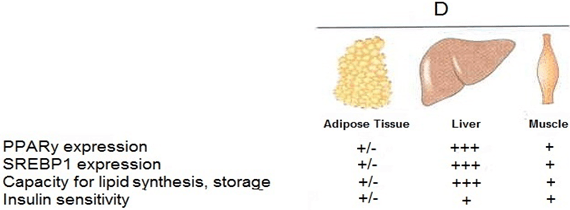This set of Molecular Endocrinology Multiple Choice Questions & Answers (MCQs) focuses on “Obesity, Metabolic Syndrome and Type 2 Diabetes”.
1. Which disease among the following is otherwise known as metabolic syndrome or syndrome X?
a) Type 2 Diabetes Mellitus
b) Type 1 Diabetes Mellitus
c) Diabetes Insipidus
d) Phenylketonuria
View Answer
Explanation: Diabetes mellitus type2, is also referred to as metabolic syndrome or syndrome X. The intermediate phase before this condition is actually referred to as syndrome X. This is characterized by obesity in the abdomen and hypertension (high blood pressure).
2. Gene expressions related with the development and formation of new adipocytes is upregulated in obese individuals.
a) True
b) False
View Answer
Explanation: The expression of genes is usually related to the growth of new adipocytes and is downregulated in obese people. But they are upregulated in other tissues, including skeletal muscle and liver.
3. What are the factors that improve the health of an individual with type 2 diabetes according to the studies?
a) Exercise and diet
b) Drugs and diet
c) Drugs, exercise and diet
d) Drugs
View Answer
Explanation: Studies suggest that the health of people with type 2 diabetes is improved by three variables. They include proper drug intervention, regular exercise and maintaining the appropriate diet.
4. Among the following, which is the drug that activates AMPK by mimicking the role of adiponectin hormone?
a) Troglitazone
b) Rosiglitazone
c) Pioglitazone
d) Biguanides: metformin
View Answer
Explanation: AMPK is activated by biguanides including metformin (Glucophage), mimicking the adiponectin effects. This increases the absorption of glucose by muscle and also the glucose intake in the liver is limited by the action of this drug.
5. The resistance to insulin that characterizes type 2 diabetes can be a result of excessive accumulation of lipids in the muscles and liver.
a) True
b) False
View Answer
Explanation: The resistance to insulin that characterizes type 2 diabetes can be due to abnormal accumulation of lipids in the muscles and liver. This is based on a reaction to lipid intake that adipose tissue cannot tolerate.
6. Which hormone degradation is prevented by inhibitors of dipeptide protease IV (DPP IV) with the action of sulfonylureas drugs?
a) Creatine kinase
b) Glucagon-like peptide-1 (GLP-1)
c) Leptin
d) Adiponectin
View Answer
Explanation: In order to induce insulin release, sulfonylureas act on the ATP-gated K+ channels in the beta cells. The proteolytic degradation of glucagon-like peptide-1 (GLP-1), is prevented by dipeptide protease IV (DPP IV) inhibitors.
7. Which among the following is the protein present in brown adipose tissue for aiding weight loss and reducing the amount of TAG that must be stored?
a) ADCEF 3
b) SMDR 1
c) PRDM16
d) SREBP1
View Answer
Explanation: In white adipose tissue, PRDM16 causes the division of preadipocytes into brown adipocytes with high thermogenin levels and uncoupled respiration. In fact, such cells might absorb fatty acids above the amount required for the production of ATP, converting energy of oxidation into heat energy.
8. What is the function of Sulfonylureas drugs in the treatment of type 2 diabetes?
a) Repairing the pancreas
b) Stimulating the expression of genes associated with type 2 diabetes mellitus
c) Increasing the glucose uptake by muscle
d) Stimulating the insulin secretion by pancreas
View Answer
Explanation: Sulfonylureas include drugs like glipizide (Glucotrol), glyburide, and glimepiride (Amaryl), etc. They directly target the pancreatic beta cells and stimulate the insulin secretion by pancreas.
9. Among the following which is the correct diagram that represents liver, adipose tissue and muscle status of an obese individual?
a)

b)

c)

d)

View Answer
Explanation: The ability of adipose tissue to hold TAGs (Triacyl glycerol) in obesity is depleted. If the expression of this transcription factor decreases in adipocytes, and increases in the liver and muscle, this may affect the fatty acid metabolism in whole. This involves the decrease in the synthesis of lipids, and the continued storage of TAGs in liver and muscle tissues.
10. What are the hormonal impairments caused by insulin resistance in type 2 diabetes?
a) Adiponectin in blood and muscle is decreased
b) Leptin in blood and muscle is decreased
c) Insulin level in blood and muscle is decreased
d) Glucagon level in blood and muscle is decreased
View Answer
Explanation: Insulin tolerance leads to dysfunction of some of the pathways by which insulin exerts its metabolic effects. This includes the effects in protein levels, enzyme functions, and regulation of transcription factors.
Sanfoundry Global Education & Learning Series – Molecular Endocrinology.
To practice all areas of Molecular Endocrinology, here is complete set of 1000+ Multiple Choice Questions and Answers.
If you find a mistake in question / option / answer, kindly take a screenshot and email to [email protected]
